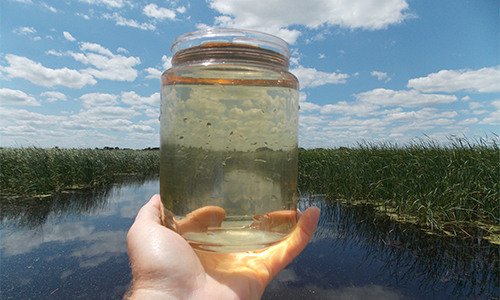The Importance of Clean and Abundant Water
Water is a crucial resource that matters to every form of life. Taking care of water supplies means protecting both quantity and quality.
Wetlands play a crucial role in water quality and the availability of water across watersheds, providing numerous benefits that positively impact wildlife, people and communities.

Water Quality
Wetlands act as natural filters for water—often referred to as nature’s kidneys. They help improve water quality by trapping and removing excess nutrients, sediments and other harmful substances.
Wetland plants, bacteria, and soil work together to help clean water before it reaches your taps. As water flows through wetlands, the plants, soils, and microorganisms within them capture sediment, fertilizer and other contaminants, improving the water’s quality before it enters lakes, rivers and groundwater reservoirs.
Benefits of Wetlands for Water Quality
- Nutrient Filtration: Wetlands filter excess nutrients from agricultural runoff, stormwater and wastewater. Plants and microorganisms in wetlands can immobilize and convert nutrients into less available forms, preventing them from entering larger bodies of water where they can fuel harmful algal blooms, degrade fisheries or even contaminate drinking water supplies.
- Sediment trapping: Wetlands trap sediments carried by runoff, preventing them from reaching rivers, lakes and ponds where these sediments can become a nuisance as they cloud the water, suffocate sensitive aquatic organisms and clog navigation channels.
- Pollutant removal: Wetlands act as biofilters, removing pollutants such as heavy metals and pesticides from water.
Water Quantity
Wetland restoration and enhancement projects can improve water quality in a variety of ways.
- Groundwater Recharge: Some wetlands, such as playa lakes and riparian wetlands, help replenish groundwater by holding water and allowing it to slowly soak through the soil, enhancing the recharge of aquifers and shallow groundwater systems.
- Flood Control: Acting as natural sponges, wetlands absorb and store excess rainfall, runoff and snowmelt, reducing the risk of heavy floods. This storage capacity moderates the flow of water into rivers and streams, preventing sudden surges that can lead to flooding.
- Drought Mitigation: During dry periods, wetlands release stored water, helping to maintain stream flows and water availability. This slow release of water supports ecosystems and communities during droughts.
Threats to Clean & Abundant Water
- Pollution
- Wetland and floodplain loss
- Land cover and land use change
- Sediment and nutrient pollution
- Climate change
- Over-extraction
How DU Conservation Improves Water Quality and Quantity
Wetland Restoration: By restoring degraded wetlands, creating new wetlands and protecting existing wetland areas to improve water quality and quantity.
Watershed Protection: Prevents erosion, sedimentation and pollution from entering larger bodies of water by implementing sustainable land management practices in watersheds.
Water Efficiency: Promotes and implements water-efficient practices to minimize water waste and optimize water use to preserve water resources and enhance water availability.
Flood Resiliency: Restoring natural floodplains, implementing effective floodplain management practices and investing in nature-based solutions, working with communities to help reduce exposure to flood risks and prevent development in high-risk areas.
Riparian Buffers: Strengthening vegetated areas along rivers, streams and lakes - known as riparian buffers - to stabilize soil, reduce erosion, filter runoff and prevent pollutants from reaching water bodies.


